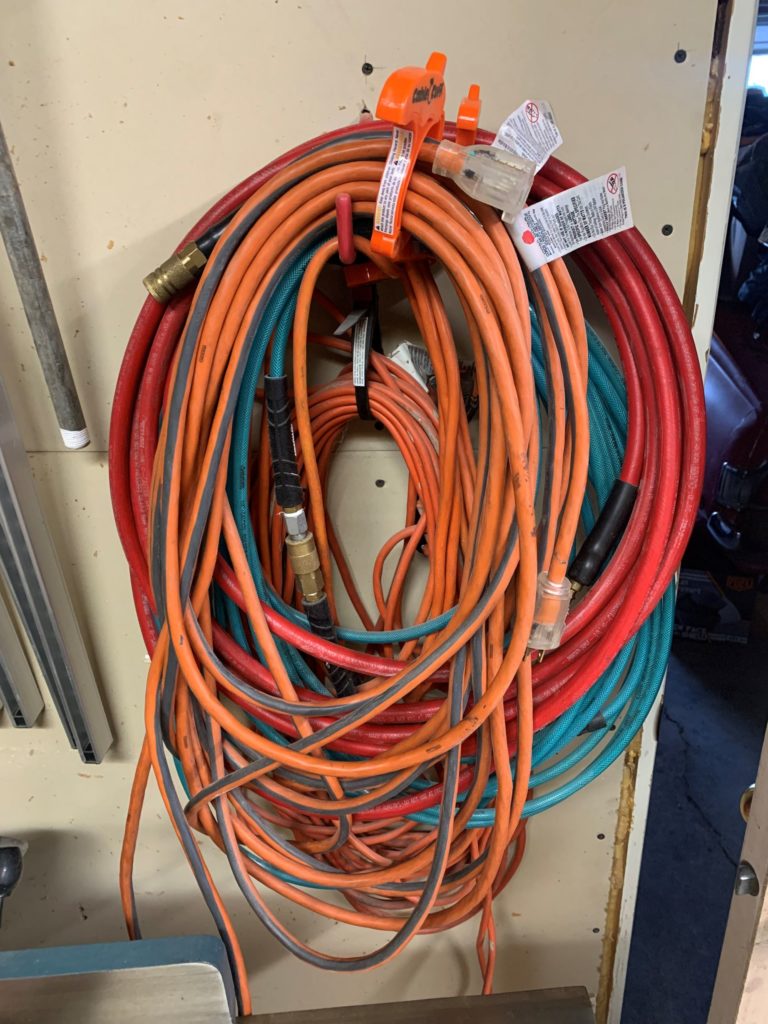Whether you have a generator or are running an inverter from your car, the power needs to get from the point of generation to the device that needs the power. It is imperative for safety and proper operation that you have a collection of appropriate extension cords.
Imagine for a minute that you were smart enough to have a generator and you needed it because of an expected, days long power outage. Because you were so smart, you also know that your refrigerator is probably good for a day or so if you do not open the doors. But what isn’t smart is running the generator inside. You need to get the power from the point of generation to the device safely.
To get further into the nuance, you not only need to get the power safely but also appropriately. Some number of years ago, we hired some painters. They were trying to run the paint sprayer on a household extension cord (these are the two wire, flat cords meant to plug in Christmas lights or something like that). Because there was so much power draw, it was tripping the circuit every ten minutes until I gave them an appropriate diameter extension cord.

The farther you need to go or the more power you need, the thicker the extension cord you need to have. The very common orange outdoor power cords are typically 16gauge wire. These are great for running drills or work lights but when it comes to heavy draw, not so much. They might work, but if something is running on a dedicated circuit, you might want to do more of a calculation to see if this is going to be adequate.
In the old days when I had more time than money, I used to read instruction manuals for power tools. It was pretty common for them to recommend different sized cords depending on the distance you are running. If you know anything about electricity, then you will know that it is code to have a minimum 14 gauge wire for a 15 amp circuit and 12 gauge wire for 20 amp circuit. So, this should be your rough guide on extension cords. And this is why you should be OK with a 16 gauge cord with devices pulling less than 10 amps of continuous use.
If you start getting tricky and adding surge protectors or other devices, they are good for some things like tripping an internal breakers to protect the device. I have some extension cords with built in breakers. They will trip if the tool load gets too high so be aware of the set and forget mentality. I use them when I want to have multiple things plugged in but not necessarily running at the same time. The more frequently a circuit breaker trips, the weaker that breaker becomes and trips much easier.
If your cord is ever hot, it is not sized for the load. It might be OK in an emergency situation or monitored use, but leaving it as a semi-permanent installation is a recipe for a potential fire. Fortunately, most devices that the home user is going to use with a generator will likely be lower draw items. But watch out for power tools and appliances for this problem.
I think that everyone knows that electricity and water do no mix. There are specific cords made for this use but they are expensive. I think a better strategy would be to not have any connections made in a wet environment (have a long enough cord). But if you have to, it is probably much more cost effective to build an enclosure. Drill some holes in a Rubbermaid style container to keep connections dry.
The cable of the extension cord is part of the system. If your cords have damage, repair or do not use. What I do if I have cords that have nicks in the insulation, I will shorten them with repair ends. If the nick is in the middle make two short ones if you can find a use for these. Electrical tape is a field repair. It will probably keep you from getting shocked, but if the conductor is damaged, it is effectively reducing the overall wire gauge and therefore decreasing the overall wattage capacity.
There is also the theory that sometimes it is better to have tool extensions rather than have longer power cords. The common adage in air compressors is add more air lines rather than extension cords. That is a high draw tool at 13-15 amps. If you had a 12 gauge cord, I wouldn’t hesitate to use it. But, most people haven’t invested $100 into an extension cord and more air hoses are always useful. For ultimate longevity, consider other options that just extension cords.
End Your Programming Routine: I didn’t realize that I was going to have so much to say about extension cords so easily. But, if we are going to generate power, it makes no sense not to be able to use it. Having sufficient lengths and quantities available when we need them so that we can do so safely and effectively is really the only thing that makes sense. Not only that, we can use them for the same reasons when the power is not off. It’s a no brainer.
Recent Comments